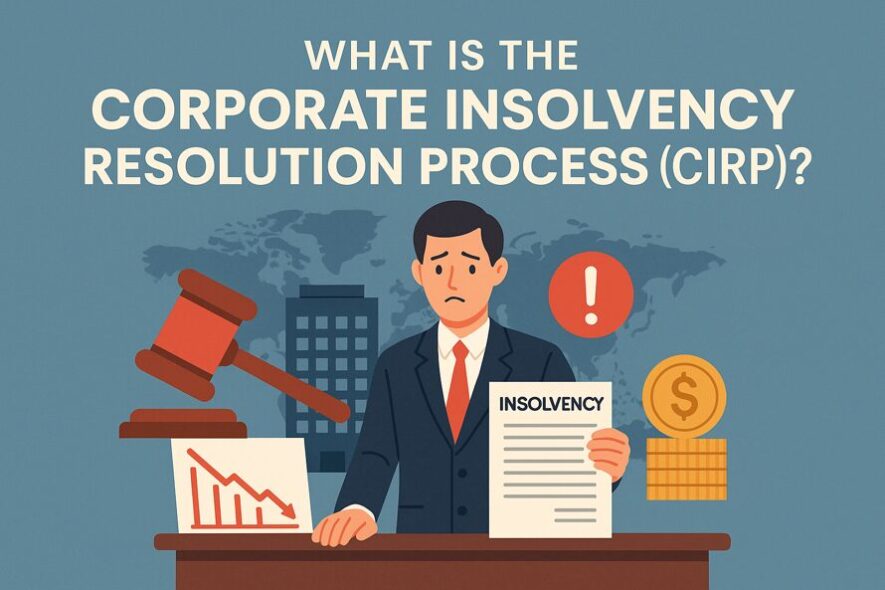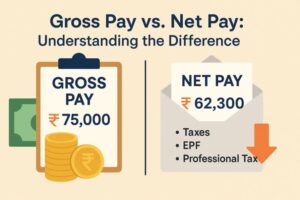
Introduction to CIRP under IBC, 2016
In India, winding up a company or rescuing it from collapse used to feel like quicksand; once you sank in, there was almost no coming out. Creditors waited for years, employees lost hope, and assets gathered dust. That changed in 2016, when the government rolled out the Insolvency and Bankruptcy Code (IBC).
At the heart of it sits the Corporate Insolvency Resolution Process (CIRP). Think of it as a playbook: a clear, time-bound roadmap for dealing with companies that default on their debts. The goal? Either revive them through restructuring or shut them down completely, without dragging the matter out for decades.
Why CIRP Was Introduced in India
CIRP wasn’t born out of theory. It was forged in response to a crisis brewing in India’s economy.
Addressing NPAs and Default Crisis
By 2016, banks were choking on Non-Performing Assets (NPAs). Corporate giants had borrowed heavily and failed to repay, leaving financial institutions in the red. Recovery mechanisms like SARFAESI and DRT moved at a snail’s pace. CIRP was meant to be the firehose, quick, decisive, and effective.
Promoting Business Continuity and Recovery
Here’s the refreshing part: CIRP didn’t just say “sell the company and be done.” It recognized that some businesses could still be saved. If restructuring debt and bringing in new investors could rescue operations, then CIRP encouraged it. That mindset shift, from liquidation-first to revival-first, was huge.
Role in Improving India’s Ease of Doing Business
For global investors, delays in closing or rescuing businesses were a nightmare. With IBC and CIRP, India showed it was serious about efficiency. This directly boosted the country’s Ease of Doing Business ranking, making India a more attractive destination for capital.
What Triggers the Corporate Insolvency Resolution Process?
CIRP doesn’t kick in for every late payment. There’s a threshold and a clear pathway to initiate it.
Default Threshold and Filing Criteria
Originally, defaults of over ₹1 lakh could trigger CIRP. Later, the bar was raised to ₹1 crore to prevent small disputes from flooding the system. Once a company crosses this threshold of default, creditors can knock on NCLT’s doors.
Who Can Initiate CIRP? (Financial, Operational Creditors, Debtor Itself)
Here’s who can light the spark:
- Financial creditors: Think banks, NBFCs, bondholders.
- Operational creditors: Suppliers, service providers, and employees.
- Even the corporate debtor itself, if it admits it can’t meet its obligations.
All three groups have the right to file before the National Company Law Tribunal (NCLT). If the tribunal admits the case, the CIRP clock starts ticking.
Step-by-Step Stages of CIRP
Once admitted, CIRP unfolds like a tightly scripted play, each act with a defined timeline.
Filing with NCLT
The story starts with a petition at NCLT. Once admitted, the tribunal declares the company officially in CIRP.
Moratorium Period
Think of this as hitting pause. From the admission date, all lawsuits, recovery actions, and enforcement proceedings against the company freeze. Creditors can’t storm the gates, giving space for restructuring discussions.
Appointment of Interim Resolution Professional (IRP)
Enter the Interim Resolution Professional (IRP). They take control of the company’s affairs, replacing the existing management. For the first time, creditors see an independent hand managing the show.
Formation of Committee of Creditors (CoC)
The IRP sets up the Committee of Creditors (CoC), made up primarily of financial creditors. Picture a council chamber where banks and lenders decide the company’s fate. This body has real power: every resolution plan lives or dies by its vote.
Submission and Approval of Resolution Plan
Resolution applicants step forward with revival blueprints. It could mean fresh capital, debt restructuring, or new ownership. The CoC weighs viability, feasibility, and recovery potential. If 66% of creditors give the nod, the plan heads to NCLT for a final seal of approval.
Liquidation if Resolution Fails
And if no plan works? Then it’s liquidation. Assets are auctioned, proceeds are distributed as per IBC’s priority waterfall, and the company shuts down. Harsh, but cleaner than dragging debt for years.
Timeline and Deadlines in CIRP Process
Here’s where CIRP shines compared to old frameworks: speed.
180 Days + 90 Days Extension Provision
The entire process is capped at 180 days, extendable by another 90 days if NCLT approves. That means a resolution must be reached in 270 days in any case. Compare that with pre-IBC delays, where cases ran 7–10 years.
Fast-Track Resolution for Small Companies
Small firms and startups get a fast-track version, 90 days with a possible 45-day extension. It ensures even smaller defaults don’t waste years in courtrooms.
Role of Key Stakeholders in CIRP
CIRP’s strength lies in its structure. Every player has a defined role.
Insolvency Professionals (IRP/RP)
The IRP, later becoming the Resolution Professional (RP), is the captain steering the ship during CIRP. They take over management, ensure compliance, and balance the interests of all parties.
Committee of Creditors (CoC)
The CoC is the ultimate decision-maker. Voting power is proportional to debt exposure. Their decisions, from approving plans to pushing for liquidation, shape the company’s destiny.
NCLT and Adjudicating Authorities
The NCLT acts as referee. It admits cases, enforces moratoriums, approves resolution plans, or orders liquidation. Without its approval, nothing in CIRP sticks.
What Happens to Company Operations During CIRP?
For employees and vendors, the immediate question is: “Does the company shut down during CIRP?” The answer: not necessarily.
Suspension of Board Powers
The Board of Directors loses its powers once the CIRP process starts. Control shifts to the IRP/RP. This ensures accountability and prevents promoters from undermining the process.
Protection from Legal Proceedings
With the moratorium in place, creditors can’t drag the company into lawsuits or asset seizures. It creates breathing space to negotiate revival.
Management by Resolution Professional
Daily operations don’t stop. The resolution professional ensures payroll, contracts, and supply chains continue wherever possible, making the company attractive for takeover bids.
Resolution Plan: What It Includes and Approval Criteria
The resolution plan is the heart of CIRP. It’s not just paperwork; it’s the company’s survival map.
Financial Restructuring Proposals
Plans may include debt-to-equity swaps, fresh investments, or staggered repayments. The idea is to restructure obligations so the business can stand on its feet again.
Viability and Feasibility Analysis
The CoC scrutinizes whether the plan is practical. Can it generate sustainable cash flow? Will creditors recover a fair value? If the math doesn’t add up, the plan is rejected.
Voting by Creditors and Final Approval by NCLT
Approval requires a two-thirds majority in the CoC. Once passed, it moves to NCLT for final sanction, making it binding on all stakeholders.
CIRP vs Liquidation: Key Differences
Here’s the key distinction: CIRP is about revival, liquidation is about closure. If CIRP works, the company continues as a going concern. In liquidation, assets are sold, debts are settled, and the company ceases to exist. CIRP preserves value where possible; liquidation is the last resort.
Success Stories and Challenges of CIRP in India
CIRP has produced big wins. Firms like Bhushan Steel and Essar Steel found new owners, secured jobs, and gave banks meaningful recoveries.
But challenges remain. Some cases stretch beyond deadlines due to litigation. Promoter resistance and procedural delays still test the system. Yet, compared to the pre-IBC era, CIRP is a leap forward.
Conclusion
The Corporate Insolvency Resolution Process (CIRP) has redefined how India deals with distressed businesses. It introduced speed, accountability, and a revival-first approach, making corporate insolvency a structured, transparent process.
Yes, hurdles exist. But CIRP has already delivered a cultural shift: businesses know defaults now carry consequences, and creditors know there’s a real chance of recovery.
In a country where insolvency once meant endless courtroom battles, CIRP has brought clarity, credibility, and confidence. That alone makes it one of India’s most impactful economic reforms in recent memory.
FAQs:
Q. What is the maximum time allowed for CIRP?
The law sets a strict deadline. A CIRP must be wrapped up in 180 days, with a possible 90-day extension if NCLT approves. That means the absolute maximum is 270 days. The idea is speed, no dragging cases for years, the way it used to happen before IBC.
Q. Who can file a CIRP petition?
Three groups can knock on the tribunal’s door: financial creditors like banks, operational creditors such as suppliers or employees, and the corporate debtor itself if it admits it can’t pay. Once the petition is admitted by NCLT, the CIRP machinery kicks in.
Q. What happens to employees during CIRP?
Employees don’t lose their jobs just because CIRP begins. The resolution professional usually keeps operations running, which means payroll continues as long as the company has funds. In fact, protecting jobs and ensuring continuity often makes the company more attractive for buyers submitting resolution plans.
Q. Can a company continue operations during CIRP?
Yes. Day-to-day business doesn’t stop. The Resolution Professional takes over management and keeps the lights on, paying staff, maintaining contracts, and preserving value. The idea is to keep the company alive while creditors decide its future.
Q. What happens if no resolution plan is approved?
If the Committee of Creditors can’t agree on a resolution plan within the deadline, the company heads into liquidation. Its assets are sold, debts are settled in a waterfall order, and the company ceases to exist as a going concern.
Q. How is CIRP different from bankruptcy?
CIRP is about resolving corporate insolvency, reviving a distressed company if possible. Bankruptcy, in the broader sense, typically signifies an inability to pay and often results in liquidation. In India, CIRP is the structured process under IBC that can end in revival or liquidation, depending on outcomes.







